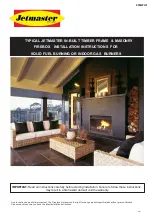
Eng
lish
INSTALLATION MANUAL
3.4 Principle of ignition cycle
Below you will find a brief description of how this appliance is ignited. The receiver in the appliance will get a
signal from the remote control to start the ignition process. The receiver will get the signal to start the ignition
process. This signal is passed on to the burner device, after which, if applicable, the relay for the Powervent
System® is switched. After an 8 second interval, the ignition on the spark electrodes will start. If no Powervent
System
®
is connected, only the relay will switch and the ignition will start immediately. The main burner will be
ignited at about 50% of its capacity. This will prevent a larger amount of gas in the combustion chamber, if no
ignition takes place. When the gas ignites, ionization will have to be detected. In order to make sure the flame has
passed over, this will take place at the other side of the burner. When ionization is detected, the gas control will
modulate to 100%.
In case of an appliance with a switchable second burner, the second valve is switched (you will be able to hear a
'click') in order to ignite the second burner. After ignition of the second burner, the appliance will always go to the
full position (full capacity). This will guarantee that the second burner will actually ignite. The second burner can
be switched on and off manually, by means of the remote control. In case of switching on manually, the appliance
will first return to full load.
!Caution
The appliance's control unit is characterized by stringent safety requirements. It is possible that the burning
appliance switches off automatically and then switches back on again. This is not a failure, but a check.
The moment the appliance's control unit is connected to mains voltage, the control unit will perform this check
every 24 hours. If the appliance is burning at that time, the appliance will extinguish and then start again
immediately.
If you wish to prevent this, you can remove the plug and insert it again at a time during the 24 hours when the
appliance is never or hardly ever burning.
4. Removing the packaging
Note the following items when removing the packaging:
Ø
Remove all packaging materials.
Ø
Remove all supplied components in, on and/or at the appliance.
Ø
Check the appliance and accessories for damages (during transport).
Ø
If necessary, contact your supplier.
Ø
Never install if an appliance is damaged!
Ø
Remove any screws that are used to fix the appliance to a platform or pallet.
!Caution
Glass is a ceramic material. Very small irregularities in the glass panes cannot be avoided, but are within the
required quality standards.
!Caution
Keep plastic bags away from children.
Appendix 2, table 1 indicates which components should be available after unpackaging.
Ø
Contact the supplier if you find that not all components have been supplied.
Ø
Packaging must be disposed of in accordance with the regulations.
5
Summary of Contents for Metro 130XTL RCH
Page 29: ...E n g l i s h INSTALLATION MANUAL 29 38C 1868 d 0 0 8 4m 0 5m 38c 744zi 1x90 5 4 ...
Page 31: ...E n g l i s h INSTALLATION MANUAL 31 S T 38c 1655 0 R U 55 38c 1656 0 15 14 ...
Page 32: ...E n g l i s h INSTALLATION MANUAL 32 38C 1977 0 L 8x 16a ...
Page 34: ...E n g l i s h INSTALLATION MANUAL 34 38P 0169 C B D E F G H A 38p 0443 25 24 ...
Page 35: ...E n g l i s h INSTALLATION MANUAL 35 38P 0442 A C B E 38p 0444 D F G H 38P 0445 26a 26b 26c ...
Page 36: ...E n g l i s h INSTALLATION MANUAL 36 38P 0446 38P 0447 38p 0448 38c 1657 0 28 27a 27b 29a ...






































